Seven Questions Over Breakfast with Beth Krommes
 September 20th, 2011 by jules
September 20th, 2011 by jules
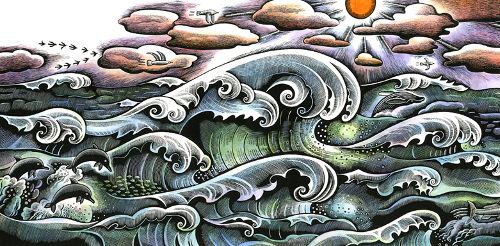
A spiral, that is. Spirals are bold. And warm and safe. And protective. And beautiful and mysterious. And much more. All depending on the creature or object in nature in which they are residing.
 These spirals in nature are the focus of the latest picture book from poet and author Joyce Sidman, Swirl by Swirl: Spirals in Nature, to be released by Houghton Mifflin next month. The illustrations for this book, which Kirkus called no less than “[e]xquisitely simple and memorable,” were rendered by Caldcott Medalist Beth Krommes, pictured here, who is joining me for a cyber-breakfast this morning.
These spirals in nature are the focus of the latest picture book from poet and author Joyce Sidman, Swirl by Swirl: Spirals in Nature, to be released by Houghton Mifflin next month. The illustrations for this book, which Kirkus called no less than “[e]xquisitely simple and memorable,” were rendered by Caldcott Medalist Beth Krommes, pictured here, who is joining me for a cyber-breakfast this morning.
Beth tells me that at 6 a.m. daily, she has strong black coffee and locally-made bread, toasted with butter. She had me at strong coffee, though I might sneak some cream into my mug during her visit this morning.
This isn’t the first time Sidman and Krommes have been paired as author and illustrator. In 2006, we saw Butterfly Eyes and Other Secrets of the Meadow (Houghton Mifflin), a collection of poetry centered around meadows. Krommes’ elegant scratchboard illustrations graced that title, and she’s back in Swirl by Swirl with more of her stunning, boldly-saturated scratchboard art.
Let it be said that Beth Krommes knows how to compose a picture on a spread. My oh my. But then we already know this from her illustrations in Susan Marie Swanson’s The House in the Night, for which the 2009 Caldecott committee awarded her the big medal for her “elegant line, illuminated with touches of golden watercolor,” which they stated evoked “the warmth and comfort of home and family, as well as the joys of exploring the wider world.”
Indeed.
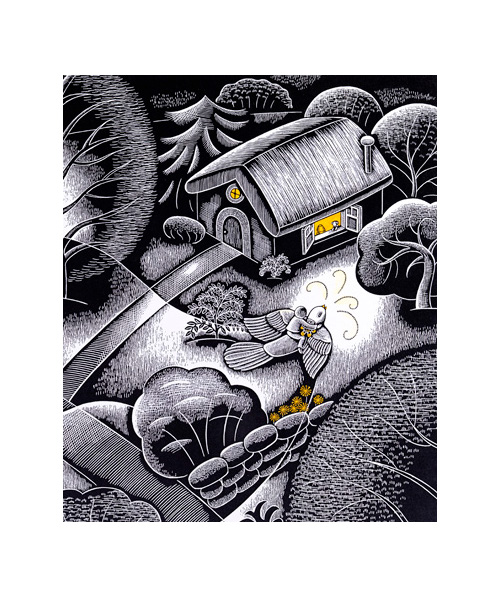
(Houghton Mifflin, 2008; click to enlarge spread slightly);
“[This second spread is a] favorite of many of my friends,” Beth adds.
But back to the gorgeous Swirl by Swirl: These illustrations are a wonder. “Krommes’ dense and richly colored scratchboard illustrations,” adds the Kirkus review, “with their closely packed and neatly labeled creatures, plants and natural phenomena, create a feeling of abundance and profusion, with so many parts of the world nestled together in swirls and spirals—effectively demonstrating its fundamental nature.” There are a few more spreads featured below in the interview, so let’s get right to it.
And I thank Beth for stopping by today . . .
Jules: Are you an illustrator or author/illustrator?
Beth: Illustrator.
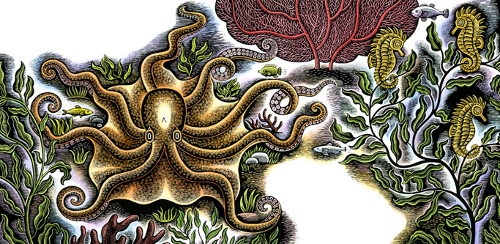

(Houghton Mifflin, October 2011)
Jules: Can you list your books-to-date?
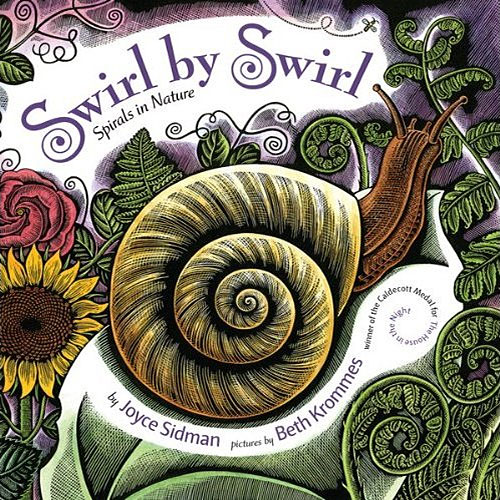
Beth: I’ve illustrated seven children’s books to date:
- Swirl by Swirl: Spirals in Nature, Joyce Sidman, Houghton Mifflin Harcourt, 2011
- The House in the Night, Susan Marie Swanson, Houghton Mifflin, 2008
- Butterfly Eyes and Other Secrets of the Meadow, Joyce Sidman, Houghton Mifflin, 2006
- The Hidden Folk, Lise Lunge-Larsen, Houghton Mifflin, 2004
- The Sun in Me: Poems about the Planet, [compiled] by Judith Nicholls, Barefoot Books, 2003
- The Lamp, the Ice, and the Boat Called Fish, Jacqueline Briggs Martin, Houghton Mifflin, 2001
- Grandmother Winter, Phyllis Root, Houghton Mifflin, 1999
Jules: What is your usual medium, or––if you use a variety—your preferred one?
Beth: For my personal art, I work as a painter (in oils or casein) and as a wood engraver. My illustration work is in scratchboard. Sometimes the work is just black and white; other times, I add color. (I explain how I do this at interview question #1.)
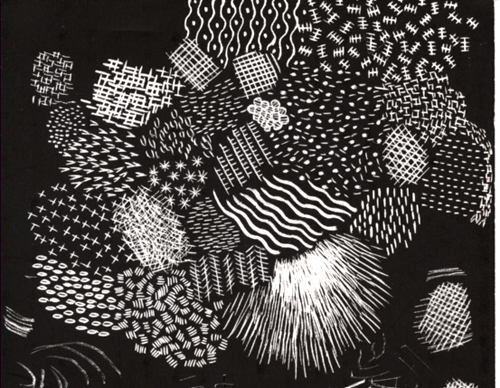
Scratchboard is a black-and-white drawing medium. The board itself is a cardboard or panel with a thin veneer of fine, white clay covered by a layer of india ink. The drawing surface starts completely black. The drawing is made by scratching white lines through the ink with a scratchboard nib held in a pen holder. The more lines that are drawn, the brighter the picture becomes. The clay coating under the ink allows the sharp point to remove the ink easily without tearing the board support. A scratchboard drawing is often very highly detailed and can resemble a wood engraving.
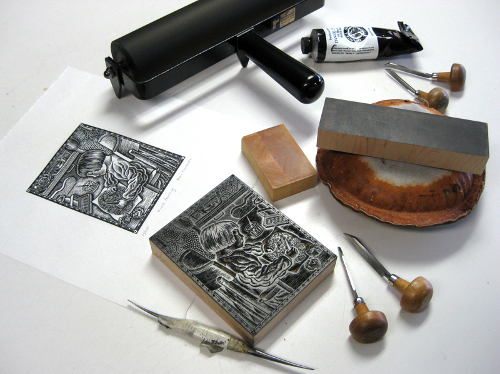
Jules: If you have illustrated for various age ranges (such as, both picture books and early reader books OR, say, picture books and chapter books), can you briefly discuss the differences, if any, in illustrating for one age group to another?
Beth: I’ve mostly illustrated for early elementary ages to grade four. It’s fun to design for the very young. I try to interpret each word of the text, sometimes on several levels. I’m not sure if I can generalize the differences in illustrating for various age groups. Each manuscript has its own needs.
(Click to enlarge)
After I finished Butterfly Eyes and Other Secrets of the Meadow, I began painting a series of meadow pictures in casein for fun. It’s become an ongoing series. Here are a few:
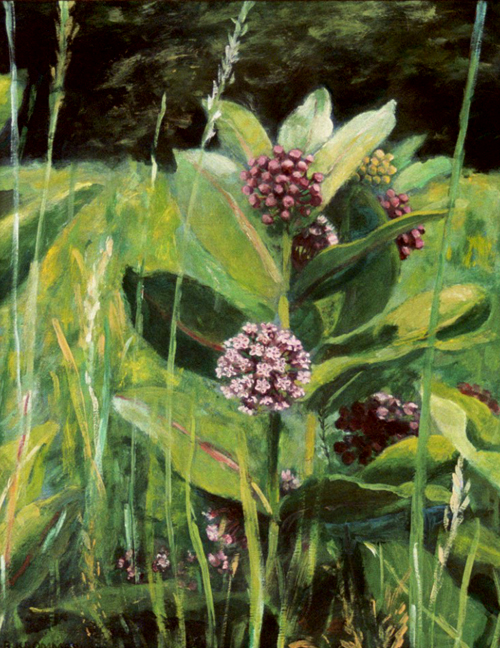

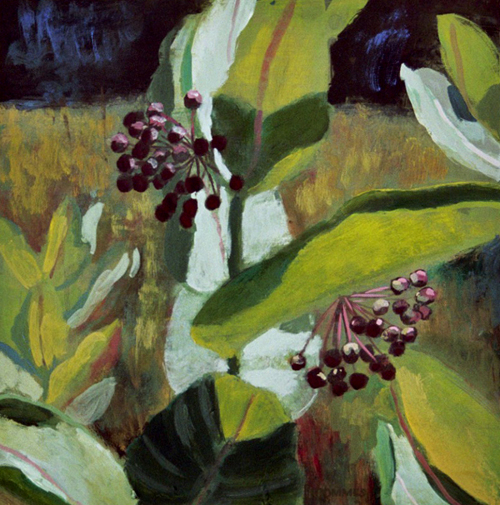
Jules: Where are your stompin’ grounds?
Beth: I live in Peterborough, New Hampshire. I grew up in Emmaus, Pennsylvania.
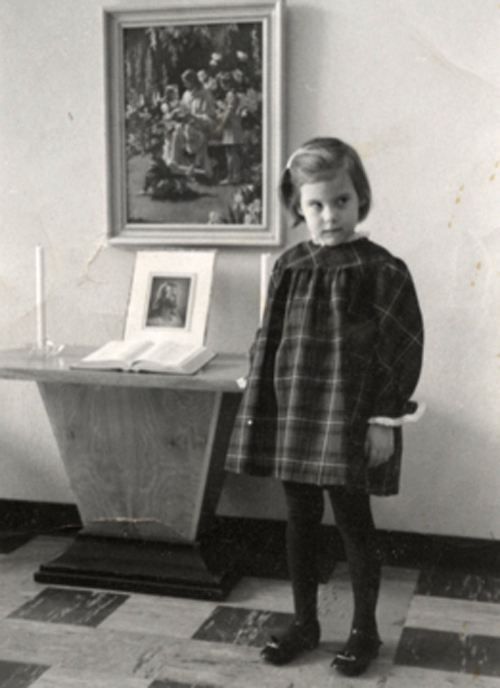


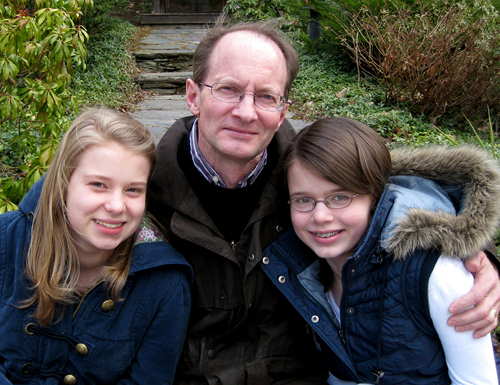
Jules: Can you briefly tell me about your road to publication?
Beth: I was 43 years old when my first children’s book was published. I had several art-related careers previously: public school art teacher, manager of a fine handcraft shop, art director for a computer magazine, and freelance illustrator for the editorial market. My way into the children’s book world was through a cover I did for Cricket Magazine that caught the eye of Ann Rider, senior editor at Houghton Mifflin.

Jules: Can you please point readers to your web site and/or blog?
Beth: www.bethkrommes.com
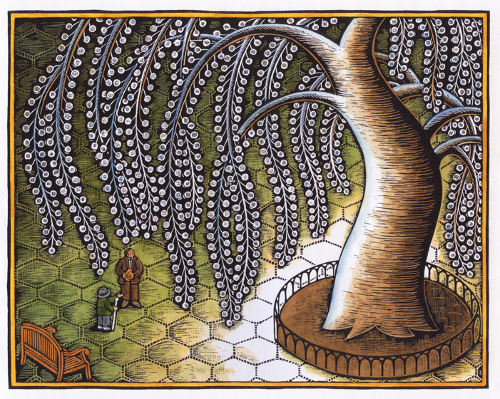
Jules: If you do school visits, tell me what they’re like.
Beth: I don’t do many school visits, only a handful a year and always fairly local. One of my favorite gigs is going to Great Brook Middle School in Antrim, NH, each year and doing presentations for the fifth graders, working with one class at a time. I love sitting on the floor with the students, talking about illustration, passing my working materials and Caldecott medal around, and having each child try their hand at scratchboard.
Jules: If you teach illustration, by chance, tell me how that influences your work as an illustrator.
Beth: I will be teaching a class this spring at the New Hampshire Institute of Art in Manchester, NH. I’m looking forward to getting out of the studio and working with college students. I gave a presentation there last year and was blown away by the staff, students, and facility. I don’t know how I am going to fit this in, but I’m excited about it.

Jules: Any new titles/projects you might be working on now that you can tell me about?
Beth: I am illustrating a book about a rain storm for Allyn Johnston at Beach Lane Press. It’s written by Dianne White and is geared for very young children. It’s so poetic. I love working on it.
 Coffee’s ready, and the table’s set now for seven questions over breakfast. Let’s get a bit more detailed, and I thank Beth again for visiting 7-Imp.
Coffee’s ready, and the table’s set now for seven questions over breakfast. Let’s get a bit more detailed, and I thank Beth again for visiting 7-Imp.
1. Jules: What exactly is your process when you are illustrating a book? You can start wherever you’d like when answering: getting initial ideas, starting to illustrate, or even what it’s like under deadline, etc. Do you outline a great deal of the book before you illustrate or just let your muse lead you on and see where you end up?
Beth: My first step after reading the text of a new book is to brainstorm all kinds of ideas and to gather images having to do with the subject. For example, when working on Butterfly Eyes and Other Secrets of the Meadow, I collected many photographs and paintings of meadows, meadow flowers, and creatures living in meadows. I wrote down everything I could think of about meadows, especially how it feels to be standing in a meadow in the height of summer. There was a phrase in the text, “the lush tapestry of meadow,” which inspired me, so I researched tapestries. Our family traveled to NYC to see the Unicorn Tapestries at the Cloisters. I taped photocopies of my favorite inspirational pictures around my office.
The next step is to work on a storyboard. This is where I chart out the length of the book, figure out what text will go on what pages, and begin to compose the pictures.
(Click to enlarge)
Now, I make a series of book dummies. These give me a more concrete idea of what the “page turn” feels like. The editor always has insightful input at this point.
Then to tight pencil roughs and, finally, the scratchboard pictures. When the black and white scratchboard pictures are done, I photocopy them onto an acid-free paper, then photo-mount the copies onto a flexible Bristol board, and apply watercolor. This is the final art that gets sent to the publisher.
The whole process of designing and completing the art for a book can take me well over a year.
Here is the progression of “In that light rests a bed” from The House in the Night:
(Click to enlarge)
(Click to enlarge)
(Click to enlarge)
(Click to enlarge)
2. Jules: Describe your studio or usual work space.
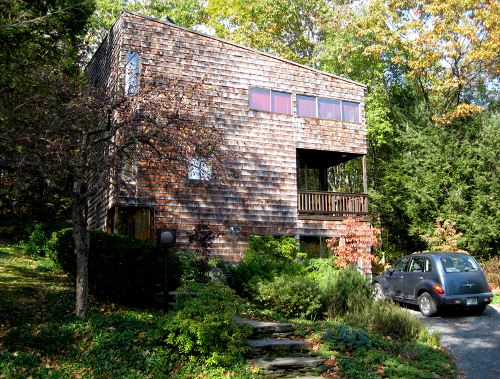
Beth: I have two work spaces in my house. I do my actual illustrating in a tiny balcony above my living room, which I call my office. I also have a space on the entry level of the house, called the studio, where I store my work and do my wood engraving, painting, and framing.
We live in a very tall modern house. I try to be organized with my materials, because there are many sets of stairs between my two work spaces. My poor knees.

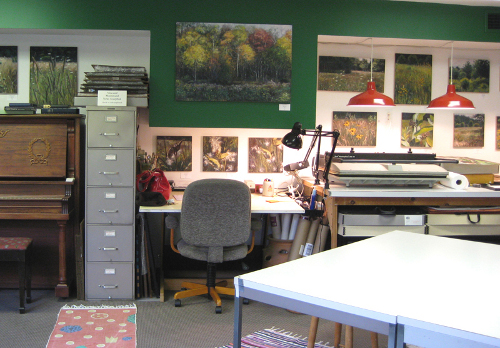
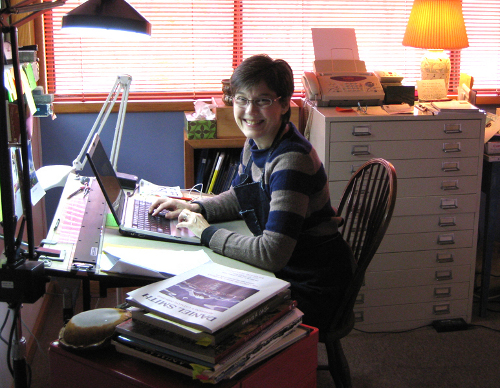
3. Jules: As a book lover, it interests me: What books or authors and/or illustrators influenced you as an early reader?
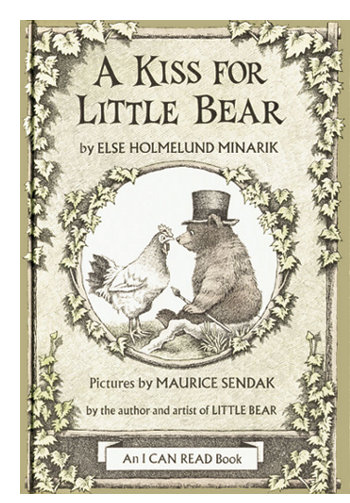 Beth: I liked everything Dr. Seuss, especially Happy Birthday to You. As I got older, I loved Nancy Drew books, Charlotte’s Web, and Harriet the Spy. When my youngest sister was born in the late ’60s, I remember admiring Sendak’s Little Bear illustrations.
Beth: I liked everything Dr. Seuss, especially Happy Birthday to You. As I got older, I loved Nancy Drew books, Charlotte’s Web, and Harriet the Spy. When my youngest sister was born in the late ’60s, I remember admiring Sendak’s Little Bear illustrations.
4. Jules: If you could have three (living) authors or illustrators—whom you have not yet met—over for coffee or a glass of rich, red wine, whom would you choose?
Beth: I’d rather choose some illustrators whom I have met, but live far away from: Carin Berger, Elisa Kleven, and Lisbeth Zwerger. I would love for us gals have a great meal together with some red wine, talking shop and other things.
5. Jules: What is currently in rotation on your iPod or loaded in your CD player? Do you listen to music while you create books?
Beth: I mostly work in quiet, but I do love Bruce Springsteen.

when working on my scratchboard.”
6. Jules: What’s one thing that most people don’t know about you?
Beth: I am a genius at organizing. Closets, basements, drawers, storage areas, you name it. The grosser, the better.

Other Secrets of the Meadow (Houghton Mifflin, 2006)
7. Jules: Is there something you wish interviewers would ask you — but never do? Feel free to ask and respond here.
Beth: If I were asked, “What was the best thing about your childhood?”, I would say:
Having the youngest of my four sisters born when I was eleven, and spending my teenage years with a little one in the house. It made me realize how much I love children and children’s books. This was reinforced when my own children were born many years later.



Jules: What is your favorite word?
Beth: “Epiphany.”
Jules: What is your least favorite word?
Beth: Not sure, but my least favorite phrase is: “Harry’s throwing up” (our cat).
Jules: What turns you on creatively, spiritually or emotionally?
Beth: Color, pattern, and black and white.
Jules: What turns you off?
Beth: Pretentious people.
Jules: What is your favorite curse word? (optional)
Beth: “Dang.”
Jules: What sound or noise do you love?
Beth: Babies laughing.
Jules: What sound or noise do you hate?
Beth: The sound of the cat throwing up on our bed in the middle of the night.
Jules: What profession other than your own would you like to attempt?
Beth: This is easy: Interior design/fabric design/art history/antiques. I’m seriously considering an “encore” career, somehow combining these fields.
Jules: What profession would you not like to do?
Beth: Law.
Jules: If Heaven exists, what would you like to hear God say when you arrive at the Pearly Gates?
Beth: “Well-done.”
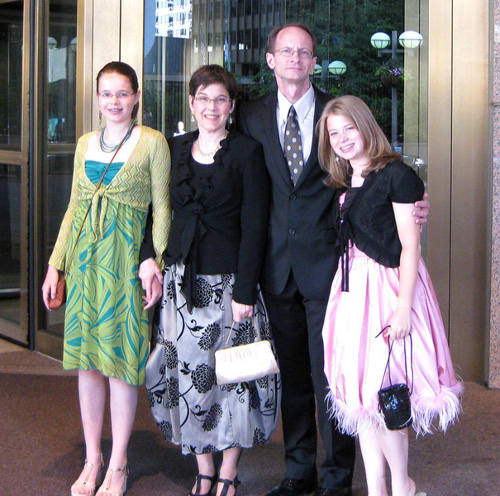

All artwork and images used with permission of Beth Krommes. All rights reserved.
SWIRL BY SWIRL: SPIRALS IN NATURE. Copyright © by 2011 by Joyce Sidman. Illustrations copyright © by 2011 by Beth Krommes. Published by Houghton Mifflin, Boston, MA.
The spiffy and slightly sinister gentleman introducing the Pivot Questionnaire is Alfred, © 2009 Matt Phelan.
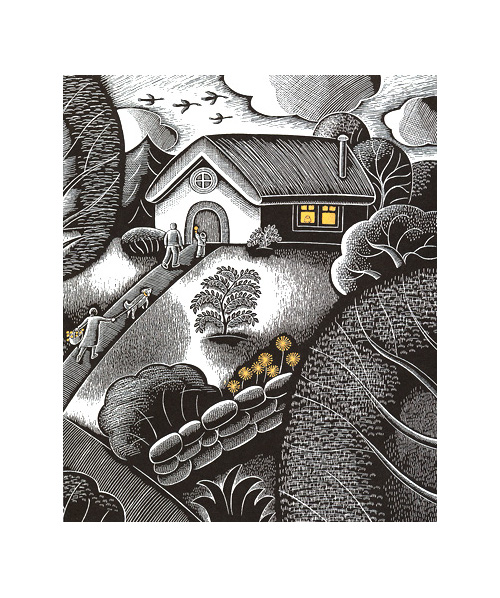

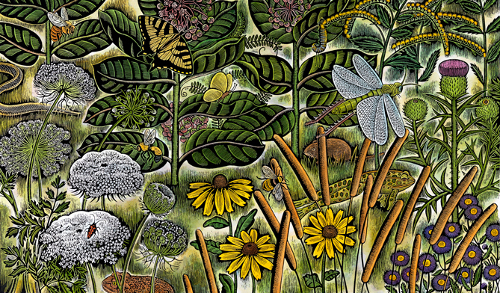
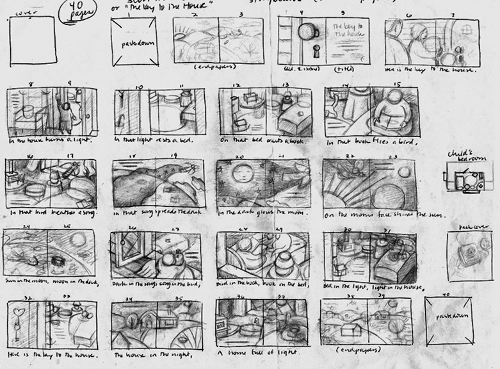
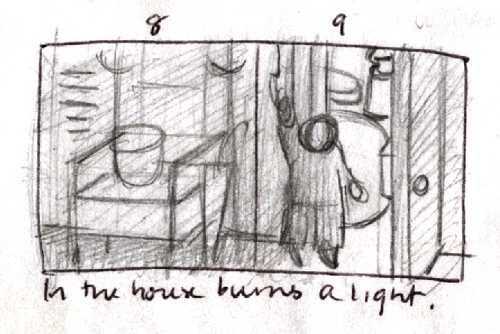

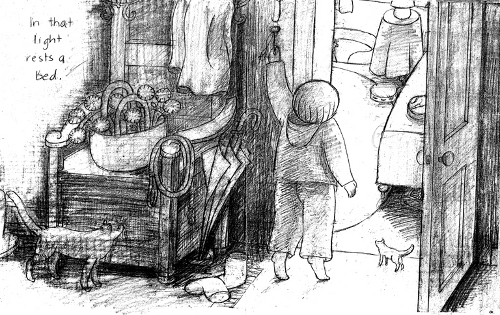

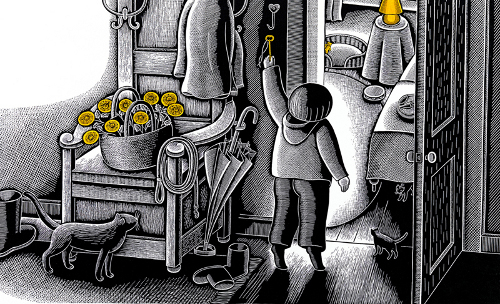

Your blog is my favorite site to drink a cup of stong coffee (with cream) and take in the beautiful art work. Thank you. Susan Miller
Jules,
Thank you for beginning my morning with another beautiful interview. Beth’s art is stunning and the process is so meticulous. I can’t wait to see the newest book.
Boy oh boy, I loved reading this interview. I got to meet Beth and her husband a couple of weeks ago and loved them both — funny and fun and unpretentious. Her warmth comes through in her work.
Love! Love! Love!
A fascinating and fun interview! Love Beth’s work — and every one of the authors’ work, too. Thank you for starting my day with such lovely images and words.
I loooooooove her! So great to see the process behind this beautiful work and the place where she makes it! THE HOUSE IN THE NIGHT is one of my favorites. Can’t wait to see SPIRALS.
Thank you so much for this wonderful interview with Beth Krommes! I was really in need of inspiration and here it is. Beth is one of my very most favoritest illustrators ever. 🙂
The waves at the top are gorgeous!!
Thanks, all.
Jill, yes, those waves (in particular) just slay me. This one is really a book to pore over … and over … and over some more.
I think Beth Krommes’s work is remarkable. I LOVE the pages from “Swirl by Swirl.” “The House In The Night” stunned me.
Wonderful interview (like all the rest)!
I was sort of staring for several minutes at the silver-tree picture — the one she describes as one of her favorites — before I realized I was subconsciously counting: number of slats on the back of the bench, number of arches in the little wrought-iron fence around the willow, number of branches on the willow and how many leaves on each branch, how many hexagonal tiles there are (or can be extrapolated) on the background… all because the whole of the thing fits together so perfectly, I think my subconscious had decided there must be some mathematical relationship among all the constituent parts. (There may be, but if so it’s something like a Fibonacci sequence or something.) I don’t think Beth mentioned math at all in the interview but I think she must be some sort of mathematical-and/or-geometric savant who may not even be aware of what she’s doing.
But I did have to laugh, a little, at her comment, “My eyes are so bad that I have to look through a magnifier when working on my scratchboard.” Because I bet her work makes a lot of optometrists happy.
Thanks so much, Jules!
This was beautiful. Thank you for sharing it with us. I was at ALA the year Beth gave her Caldecott speech. She was lovely and sincere and her speech brought tears to my eyes because of the years of faithfulness she had put into her work. It made me grateful the committee recognized her.
Thanks for the stunning art and interview. Hope to meet up again sometime, Beth!
Lovely interview with a wonderful artist!
Great interview. Thank you!
Great interview! Hooray for New Hampshire children’s book creators! Thank you!
What a lovely and inspiring way to start the day. If Beth designs fabric as an encore, I’ll be first in line.
What a fantastic interview! So thorough and inspiring – the photos, artwork, questions and answers – thank you both!
Jules,
Great interview! I love Beth’s art–and I love Joyce Sidman’s writing. I’ve already ordered a copy of “Swirl by Swirl.” Can’t wait to read it.
What a fabulous blog and what a wonderful illustrator! I am buying all your books. Jules, keep up the detailed interviews, which include the process the artist goes through in creation. Your blog is “bookmarked” !
I am really enjoying your blog – gorgeous. This was an absolutely delicious entry. The illustrations you’ve selected from her various books are just beautiful. I’m originally from New Hampshire so I love knowing she is from Peterborough! – thank you.
Beautiful interview! Beautiful art! Thank you!
Thats great work there is dedication in the works.
I really enjoyed this blog. Very inspiring interview! Beautiful illustrations!
Many compliments for the great work! Thank you for sharing it with us! Greetings from Belgium,
Manuel thewoodengraver.blogspot.com
P.s. I grew up whit the Little Bear’s stories!:)
[…] discovered the work of Beth Krommes, and in the process found a really nice interview called Seven Questions Over Breakfast with Beth Krommes. In it there are examples of her work, with an explanation and story boards showing how she creates […]
How do you copy your art onto acid-free paper? Do you have a special kind of scanner, tray bed?
soooooooooooo beautyful work &effective style
thank you Beth for your detailed description. Thank you jules for the interview
Manoj
How can I follow your blog? I like it!
Wow, this was awesome you really put all your effort in each draw you make, i hope i can have that conviction one day, this was awesome ^.^
[…] like to learn more about illustrator Beth Krommes, you can visit her website. You also can read this interview with her on the notable blog Seven Impossible Things Before […]
What a fabulous interview! Beth Krommes is featured in the book, Storybook Art, by myself and Jean Potter. We tie Beth’s art style to an etching activity the kids can do to feel what Beth feels in creating an etching artwork. Beth was one of the nicest authors interviewed for my book, and I’ll always remember that she wrote a thank you note for being included. I agree with her least favorite word, and with her least favorite sound, so we have all that in common. Beth is terrific and an amazing talent.
[…] http://blaine.org/sevenimpossiblethings/?p=2206 […]
[…] love scratchboard illustration. It’s hard to understand how it works, but Seven Impossible Things blog helped me better understand its challenges. I am just blown away by the photo of Krommes, hunched […]
[…] Illustrator website Illustrator interview: Seven Impossible Things Before Breakfast Illustrator video interview: Eric Carle […]
Hello Beth Krommes,
My favorite book in Kindergarten was:
While Susie Sleeps Hardcover – 1958
by Nina Schneider (Author), Dagmar Wilson (Illustrator)
When your caldecott winner came out I was thrilled to once again see the …colors of the road… used so effectively. Thank you! I have learned how to tolerate driving, by loving this combination of colors…if you will, and live on!
I eat your illustrations up. I bet you sleep like a baby at night, with such an imagination and such skill with which you share. Thank you,
Peggy Adair
“The Lamp, the Ice, and the Boat Called Fish” is still my favorite, probably because of all the research you did, and how accurately you depicted it all, the tools, the clothing, everything related to the time and the place.